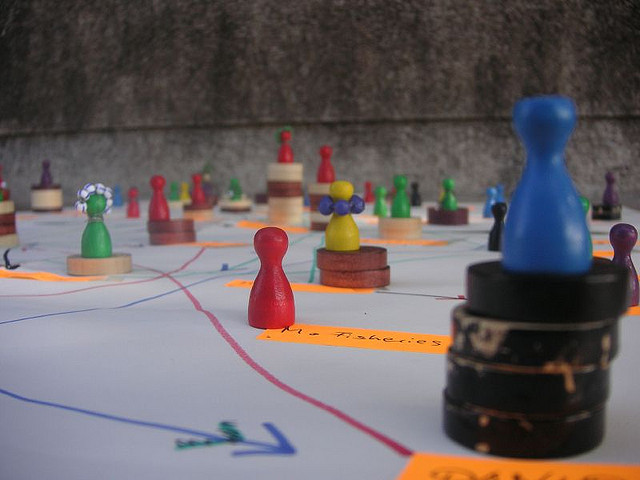Appearances can be deceiving: There’s always a backstory, the behind-the-scenes truths of how we moved from point A to point B. How the intangible dynamics of power structures, information pathways, and spheres of influence ultimately shape policy outcomes is challenging to decipher—but understanding the various actors, belief systems, channels, and motives in play is essential to the development of effective policies and programs.
One way IFPRI researchers have been investigating the backstory of food policy is through social network analysis, applying tools such as Net-Map.
Created by former IFPRI Research Fellow Eva Schiffer, Net-Map is a tool that provides a low-cost and low-tech means of social network analysis. According to Schiffer it is an “interview-based mapping tool that helps people understand, visualize, discuss, and improve situations in which many different actors influence outcomes.”
Net-Map can be applied to a host of situations to better understand natural resource governance, pinpoint information breakdowns that lead to the spread of disease, identify the weak links in relationships between institutions, and more. What sets Net-Map apart from other tools is its ability to unearth the informal relationships and interactions that might otherwise go undetected in the review of official documents on formal policymaking procedures.
In an April 2013 discussion paper, “The Policy Landscape of Agricultural Water Management in Pakistan,” IFPRI researchers applied the Net-Map method to cultivate a better understanding of Pakistan’s water sector and how to engage stakeholders to improve water conservation efforts. The challenge, explained the study, is for Pakistan to “start an open debate on how the interlinked objectives of water, energy, and food security can be jointly achieved, at minimal cost and maximum benefit for the Pakistani people.”
Researchers employed a two-pronged interview approach, meeting with both national stakeholders in Islamabad and provincial stakeholders in the Punjab province, creating two distinct maps of influence. The interview questions zeroed in on four types of relationships: formal authority, informal pressure, technical information, and funding. The national level interview set out to discern policy influence at the national level whereas the provincial interview focused on water policy influence in the region of Punjab.
As a group exercise, the participants nominated important actors, and indicated linkages, power flows, information channels, and funding streams. Participants ranked each actor on their degree of influence; on a scale ranging from 0 to 5 in Punjab and 0 to 3 in the national exercise. Based on this process, the groups produced two physical diagrams of the perceived relationships, one at the national and one at the provincial level.
At the national level, researchers found the network to be highly centralized, with the power core consisting of the Ministry of Finance, the Ministry of Planning and Development, and the provincial government, and other actors falling to the outskirts. Conversely, at the provincial level, the network was comprised of a very low degree of centralization, indicating “a relatively equal level of participation among all the actors.” Interestingly enough, in Punjab, exchange of information appeared to be free-flowing in both directions. “All those who receive technical information from another actor also provide it,” noted the researchers. However, the Provincial Irrigation Department (PID) certainly wields power at the provincial level, participants having described PID as “the powerful owner of water in Punjab.”
So what do these relationship revelations suggest for policy and research agendas moving forward? The interviews indicated that there is a vacuum in capacity building and management training for agricultural water management: “the ‘best and brightest’ do not enter this sector due to a lack of a clear career path…and the fact that the sector is controlled by political appointees.” The exercise also exposed the destructive nature of competition for authority, resources, and policy influence among the various stakeholders, relegating the achievement of common goals to second place. The study noted that such power plays have hindered reform efforts that could address redundancy and inefficiencies in both PID and the Punjab Irrigation and Drainage Authority.
At the end of the day, a better understanding of policy landscapes results in better policy. Researchers found that the Net-Map process was successful in “illuminating common perceptions of the institutional environment of water management policy, eliciting views on the obstacles to a successful policy reform process, and identifying the most influential and central stakeholders.”
Related Links







